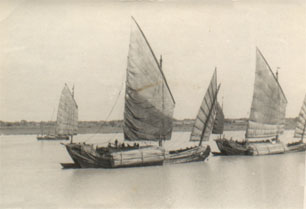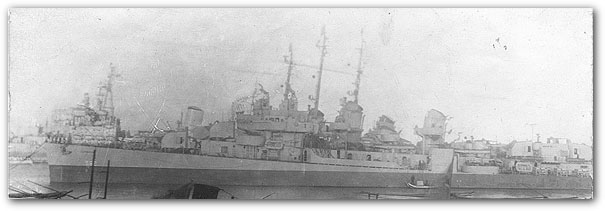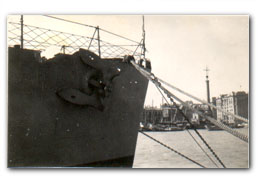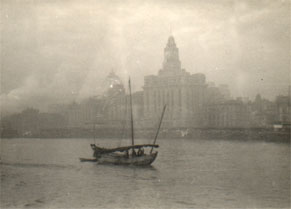|
Yangtze Patrol Force, Task Group 73.2Plus Other Noteworthy Events and People, e.g., River Rats & Forty Thieves "Man overboard astern! Away the motor whaleboat! Doctor to the bridge!" These startling pronouncements from the squawk box hit us like a brick bat, destroying the reveries we were enjoying. We were lying at anchor, all alone, war over, waiting for our brood of yard mine sweepers (aka YMSs) to catch up, dreaming either of returning to home-sweet-home, some thousands of miles to our east, or making liberty in Shanghai, a scant 30 river miles to our west. Technically, we were in China, the first ship of our size and nationality to enter the Yangtze River since the onset of hostilities in 1941. There was the brownish cast of the water, and the taut anchor chain to prove that we were in the mouth of the Yangtze, as our navigation indicated, yet we were out of sight of land. An off-shore breeze brought us occasional whiffs suggestive of the presence of humanity, and causing us to speculate idly on how the local farmers were fertilizing their fields. All who could, rushed the rails and craned their heads aft to catch a glimpse of the unfortunate overboard person. There he was, a good quarter of a mile astern, swimming a creditable, almost relaxed, crawl stroke toward us, but losing ground to the strong adverse current of the mighty river. The squawk box came back on: "Lt. Kinder, report to the bridge, on the double." This was definitely the Captain’s voice, and he was clearly perturbed that Dr. K had not yet put in an appearance. By now, the motor whaleboat had been ‘awayed’, and was soon closing on the hapless swimmer. But there was yet no doctor to meet and treat the victim on his return. The next few minutes were tense indeed, with another squawk for the immediate appearance of the doctor - again to no avail. (Keep in mind that this entire episode was being witnessed first hand by our Captain’s immediate superior afloat, the Task Group Commander, ensconced on the Robbie). As the motor whaleboat approached the ship on its return, the terrible truth was suddenly revealed to all - the man overboard was the ship’s doctor! It seems that Dr. K. had been chatting with a group gathered on the fantail, and had accepted a challenge to leap overboard for some small monetary consideration. Everyone knew that Dr. K. was a sucker for such challenges. He had once, spurred by a $1 offer, reared backwards into the drink out of a whaleboat underway in Ulithi lagoon - no thought for what might have been in his pockets, on his head or hands, or in the water (e.g., the boat’s screw). So what kind of punishment do you suppose the Captain meted out for this outrageous behavior? Right. None (at least none visible to the rest of the crew). Our ship was allotted just one doctor, and he was accorded the utmost respect as the prime guarantor of the crew’s health while far from hospital ship or shore-based medical facility. Dr. K had replaced our original (Lt. Dupler) doctor several months before the man overboard fiasco. He was one of a kind - a handsome young lieutenant from the ‘main line’ of Philadelphia, fresh out of residency, vigorous, friendly, and obviously delighted to have a captive practice of some 350 souls, even if all males. In his relatively short tenancy aboard, he had performed an appendectomy underway, and had started or continued several campaigns against disease, including one to circumcise all the uncircumcised among us. How close he came to this goal is not known. The operations were done in the relative security of sick bay. We could only speculate, based upon how our shipmates paced the deck, who had been so clipped. But when it came to Jungle Rot (aka Jock Itch), there was no need to speculate. This affliction was so endemic in tropical climes aboard ship as to require public treatment. Each morning, at sick call, you could watch the JR patients line up on the main deck aft, naked from their waists down, legs spread apart, hands clutching whatever needed clutching, waiting for that one-pass, stem to stern, of the big swab in the hands of Dr. K. or one of his pharmacist’s mates. Roughly the size and shape of a belaying pin, the swab was dipped in a bucket of foul-smelling purple soup before each application. The treatment ended when the application dried. Miraculously, it worked! (Our laundrymen were not too happy about getting the purple out of the skivvies, however). By jumping overboard into the Yangtze River, Dr. K. became the very first post-WW2 ‘Real River Rat’, a distinction we were blissfully unaware of at the time. Sure, we knew that the old U. S. Asiatic Fleet maintained a gunboat presence on the river before the war - the original Yangtze Patrol Force, aka ‘YangPat’, our namesake. Some of us remembered the notorious ‘Panay Incident’, where, on 12 December 1937, Japanese bombers sank the USS Panay (PG45) in the Yangtze near Nanking without provocation, ignoring the state of neutrality existing then between Japan and the U.S. We saw ourselves as a revival of the old YangPat. Only much later did we learn that the pre-war YangPat sailors were fond of referring to themselves as ‘River Rats’, and that to qualify as a Real River Rat, you must have been whole-body baptized in the River’s waters. Most pre-war baptisms occurred by accident while negotiating a return to one’s ship after a fun evening liberty ashore. Whether anyone on the Robbie other than Dr. K qualified as a Real (baptized) River Rat is beyond recall (refute this, if you can). Aware, as we were, of what the river carried to the sea aside from water, most of us avoided direct contact. River Rats aside, we were there in the mouth of the Yangtze to do a serious job. Loosely worded, it was to do what was needed to restore safe sea-borne access to Shanghai and Nanking. Our orders to report to Subic Bay and join in the formation of the Yangtze Patrol Force came hot on the heels of a V-J Day ‘celebration-of-sorts’ off Ulithi. We reached Subic Bay on 21 August 1945 by way of very familiar waters - Leyte Gulf, Surigao Strait, Mindanao and Sulu Seas, Mindoro Strait and South China Sea. One of the several days we spent at Subic Bay, 2 September, is remembered as the day the Japanese signed the surrender agreement on the deck of the USS Missouri in Tokyo Bay. After several days of preparation for our new assignment, we departed for Okinawa, accompanied by the cruisers St. Louis and Nashville, and our DesRon22 sisters Waller and Saufley. This leg of our journey was noteworthy in that we encountered a powerful storm, reported to have sunk an oiler, during which Dr. K distinguished himself by removing an inflamed appendix from one of our crew - while not feeling very well himself. Our wardroom with its big mess table served as his not-so-stable operating room. The patient survived and thrived. Arriving 5 September at Buckner Bay, we were impressed by the ‘big iron’ anchored therein, ironically including six hospital ships. We paused only long enough to pick up a group of nine small minesweepers before setting sail for the China coast. Our first priority task was to dispose of whatever mines might be lurking in the navigable waters near the mouth of the Yangtze, and up the Yangtze to its confluence with the Shanghai-skirting Whangpoo River. A day or two were spent by our YMSs clearing channels around the tiny Saddle Island group, which could have benefited only the fishermen of the local villages. 
One day, what to our wondering eyes should appear but an LST-like landing craft flying a rising-sun ensign! We went to GQ post haste, and soon were leveling our 5" guns at her and ordering her to halt and receive a boarding party. We hoped these guys knew the war was over - and that they had lost! They did! Even so, we spoiled their day by relieving them of all their small arms and minefield charts. Robbie may have been a lot of things to her crew, but a sweeper of mines she was not. She carried no paravanes, no sweep cable, no streaming gear. Put another way, she was no USS Caine (DMS 22, Herman Wouk’s fictional domain of the notorious Capt. Queeg, and site of the ‘Caine Mutiny’). What she did soon have was a brood of two dozen YMSs temporarily under her wings. These small ships, especially designed and rigged for sweeping, would do the dirty work, whilst the Robbie acted as their shepherd. Rather than shepherd, you could better compare our role to that of the flight controllers in an airport tower. Anchored in the big river to the side of a minefield, we tracked, visually and by radar, the progress of the YMSs on the mine field charts provided somewhat reluctantly by our recent enemy. When a lead YMS was observed to have completed its sweep path, we would so notify it, and coach it onto its next path. This was, apparently, a great help to the small wooden-hulled vessels, as burdened as they were with the details of sweeping mines while battling the river’s adverse current.

Maybe twice a day, we would get up steam and move to a new anchorage about a half mile upstream of the last one. Then, after taking a new set of bearings, the YMSs would be guided to new paths and continue the routine. Sweeping was discontinued before sunset, and resumed after sunrise. And so it went, ad infinitum, day after day, week after week. "Lullaby Niner, this is Director. You are at the end of your path, turn one six zero." "Roger, Director, turning one six zero". Time hung heavily on our hands. We were especially dismayed to watch our sister and cousin navy ships waltz right by our mine sweeping operations on their way to Shanghai - and sweet liberty. "What did they ever do to deserve liberty before us?" we wondered aloud. Twice the monotony was broken briefly, once when Lt. Zumwalt and a prize crew were detached to sail the ‘captured’ Japanese gunboat Ataka into Shanghai, and again when we felt impelled to fire a warning shot across the bow of a Chinese vessel we had ordered to halt and drop anchor. Turned out its crew simply could not read our signal hoist (but they had no difficulty reading our shot across the bow). But aside from these distractions, we had very little to show for our efforts. Only a handful of ‘possible’ floaters had been sighted by the YMS crews, none had been exploded by gunfire. We surmised that the river’s current, aided and abetted by tidal effects, had done most of our work for us months or years earlier. We persisted, until one day we could claim we had finished the job - all known minefields between Shanghai and the South China Sea had been swept! Then came the long awaited order for Robbie to proceed to Shanghai. It was 23 September 1945, a day to remember. We picked up a river pilot and proceeded cautiously up the winding Whangpoo River headed for a Shanghai mooring twelve miles upstream. Passing lush farmlands on either side, we were touched by the friendly waves from the people on the banks. These were the first Chinese we had seen closely enough to know they were smiling. They obviously were happy to see us, happy the long war and occupation were finally ended.  Shanghai Mooring 18 November 1945 - Robbie nested with sisters and cousins in the Whangpoo River, Shanghai, China Rounding a last bend in the river, there appeared our dreamed of liberty port - Shanghai! We passed the mouth of Soochow Creek with its bomb-damaged bridge to starboard, and tied up bow and stern to mooring buoys opposite the famous Bund and the city center. We were not alone. There were a couple of cruisers and a command ship here already - and we were nested with another DD and a DE. These were the ships which we had watched with envy as they passed our mine sweeping operation on the big river. With all secured, there was little to do but wait our turns ashore. And when the time came, we climbed into our whaleboat and made for the fleet boat landing on the Bund. There we were confronted by a huge, bamboo-framed sign facing the river, bearing the words "Welcome Victorious U. S. Seventh Fleet". And were we ever!! 
This was our first, happily not our last, visit to Shanghai. On 22 October, those of us with ‘the liberty’, appeared at a Russian Orthodox Church, and formed an honor guard at the wedding of our Bud Zumwalt to his Shanghai bride, Mouza Coutelais-du-Roche. We had not seen Lt. Zumwalt since we saw him off at the mouth of the big river some 6 weeks earlier, to sail the IJN Ataka into town. He had obviously had his mind on non-naval matters in the interval. We were treated very well by all - the merchants, the restaurateurs, barkeepers, pedicab peddlers, ricksha pullers, and especially the people on the streets, as on our favorite Bubbling Well Road. One got the idea that our presence was much preferred over whatever preceded it. By the time we said our final farewell to the City in December, we had many new friends to include in our ‘ding hao’s. There was still work to be done. Ship traffic in and out of town had picked up noticeably, as you might expect. We were next assigned to be the HECV, or harbor entrance control vessel, for the port. As such, we occupied an anchorage in the Yangtze close to the mouth of the Whangpoo River, a place known locally as Woosung. While our official duties included control of the flow of river traffic in and out of Shanghai, our actual involvement is better described as floating post office, movie exchange and pilot stopover. There were always ships anchored nearby, awaiting their turns to enter or leave, exchanging signals with each other, looking for mail or movies or pilots. Ah, the river pilots! Now there was an interesting lot! No ship of any size could traverse the Whangpoo between Shanghai and Woosung without one of these specialists in control. And when they finished delivering a ship to Woosung, they boarded the Robinson to await their next inbound opportunity. Their diversity was notable, their stories spellbinding, their friendliness touching. They were French, and Scotch, and Spanish, and Brazilian, and American, and, yes, Chinese. Some had spent the war in Japanese prisons. All were adventurers of one sort or another, brought together by some magnetic force to this venue and this career. Foc’sle movies excited and fascinated these world-wise pilots as if they were school kids - but that was understandable, considering how they had spent the war years. Some of these pilots, all members of the Shanghai Pilots Association, could recall the old pre-war days, when China’s rivers were prowled by the navies of France, England, Russia, Japan and the U. S. They were known to the old River Rats as "The Forty Thieves", a nickname they had come to in view of the high fees they charged. We only learned of this many years later. One of the old Forty Thieves - Columbus D. Smith - had an interesting USN background. Early in his Navy career, he distinguished himself as an ensign in command of a wooden-hulled subchaser in WW1. Awarded the Navy Cross, he later became a skipper for the Yangtze Rapid Steamship Company for several years, then joined the Forty Thieves. There he befriended another ex-navy Thief - ex-RAdm T. Kikuchi, a Japanese hero of the Russo-Japanese War. T. Kikuchi, in turn, introduced Smith to another ex-admiral, Kichisaburo Nomura, a visitor to Shanghai. Nomura was then a Japanese diplomat, destined to become infamous for his 1941 role in assuring Pres. Roosevelt that the Japanese meant no harm, knowing that the Japanese carriers were underway for Pearl Harbor at that very moment. Smith’s links to the Japanese via the Forty Thieves initially softened his time in Japanese navy prison, but later made no difference to the Japanese Army. We made one quick side trip in early December - to Tsingtao, 300 miles north on the China coast. Our assignment was to pick up a U.S. general and return him to Shanghai. But when we arrived there, the cupboard was bare. Our ‘fare’ had proceeded to Shanghai by other means. What an expensive ‘no-show’ that was! While refueling, some of us found our way ashore to a local horse race track. We were astonished at the size of the horses - so small their jockeys seemed to be scraping the track with their feet while underway. At the fleet post office, we found no ‘general’ mail, but we did pick up rumblings of concern that Mao Tse-tung and his communist gang would soon sweep over Tsingtao, turning out the lights of freedom so recently turned on. Mao was in the process of forcing Chiang Kai-shek’s army and Kuomintang followers relentlessly southward toward Formosa, their eventual island refuge renamed Taiwan. We left without being able to sample the town’s now-famous Tsingtao Beer, thoughtfully brewed by a local German enclave. By now, our justification for lingering near Shanghai had vanished. Our HECV functions had been handed over to local civil governments, and our national interests in the area no longer included a naval river presence - a ‘YangPat’. When our orders came to return to good old Uncle Sugar via San Diego, we were ready and willing to comply. Many of us had been out of country since our ship set out for the war in April 1944; all (but two) were longing to return home to loved ones. The City of Shanghai invited us to a farewell party that none of us who remember attending will ever forget. Wine, women, food and acrobatic dancers (Pan’s Troupe) were there to entertain us. And entertain they did. 
The next day, 12 December 1945, we cast off our moorings and headed down the Whangpoo for the last time. Watching the familiar Shanghai skyline fade in the distance was a bitter sweet experience. In the best of China Station traditions, we proudly flew a ‘homeward bound’ pennant from ‘Little Robbie’s’ signal yard. About the same length as our ship and a foot wide, it fluttered over our heads and past our stern, occasionally kissing the river water in our wake. Each linear foot of the pennant stood for one of us, and we each later received our cut-off foot length as a fitting memento of an experience of a lifetime. Our orders to return to the States included all of DesRon22, so we enjoyed the company of our dear sisters: Saufley, Waller and Philip. Our return was uneventful - no storms, no medical emergencies, no kamikazes. On the 18th we paused at Eniwetok for fuel, and again on the 23rd at Pearl Harbor. We reached San Diego in the early morning of the 30th, noting with satisfaction the big "Welcome Home, Well Done" sign erected next to the Point Loma lighthouse. After an agonizing 2-hour delay off North Island, waiting for fog to disperse, we waltzed on in, tied up at the Naval Repair Base and rushed ashore in search of …ice cream. It was great to be back home again! In the land of the free, and the home of the ice cream cone.
|